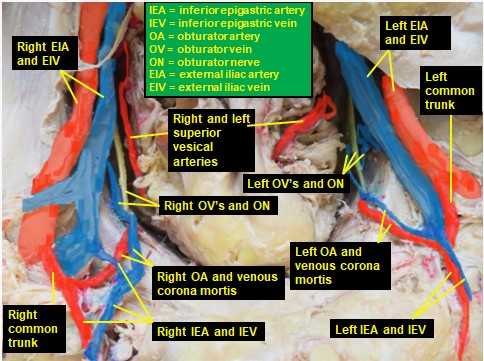*Correspondence to: Chernet Bahru Tessema, Department of Biomedical Sciences, School of Medicine and Health Sciences, University of North Dakota, USA
Received: Aug 08, 2023; Accepted: Aug 17, 2023; Published: Aug 23, 2023
Citation: Tessema CB (2023) Bilateral Common Origin of Obturator and Inferior epigastric Arteries from the External Iliac Arteries, Accompanied by Venous Corona Mortis Duplicated on the Left Hemi-Pelvis. J Anatomical Variation and Clinical Case Report 1:105. DOI: 10.61309/javccr.1000105
Copyright: ©2023 Tessema CB. This is an open-access article distributed under the terms of the Creative Commons Attribution License, which permits unrestricted use, distribution, and reproduction in any medium, provided the original author and source are credited.
ABSTRACT
During the dissection of the pelvis of a 93-year-old female donor, aberrant obturator artery and inferior epigastric artery were found to arise by a common trunk from the external iliac arteries bilaterally. Both right and left AOAs descended into the lesser pelvis with a venous corona mortis and entered the obturator canal on its anterolateral wall where each artery is joined by two (superior and inferior) obturator veins (OVs) and the obturator nerve on the respective side. The bilateral venous corona mortis connected the superior obturator veins with inferior epigastric veins, while on left hemi-pelvis, a second venous corona mortis additionally connected the inferior obturator vein with external iliac vein. These variant pelvic vessels are prone to injuries by trauma during accidents, iatrogenic injuries during inguinal and femoral hernia operations, and other orthopedic, gynecologic and urologic procedures. Such injuries have high morbidity and mortality rate due to hemorrhagic shock, therefore, caution must be exercised to avoid excessive hemorrhage and other complications.
Keywords: External iliac artery; External iliac vein; Inferior epigastric artery; Inferior epigastric vein; Aberrant obturator artery; Obturator vein; Venous corona mortis

Figure 1: Superior view of the pelvis illustrating the origins of the common arterial trunks from the external iliac arteries (EIAs) and their bifurcation into ascending and descending branches that formed the AOAs and IEAs respectively. It also shows the bilateral VCM accompanying the AOAs in their course to the obturator canal.
